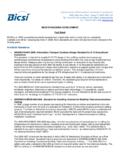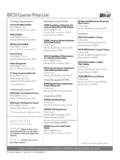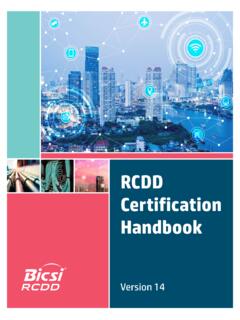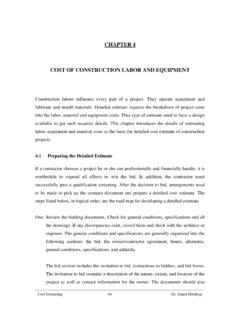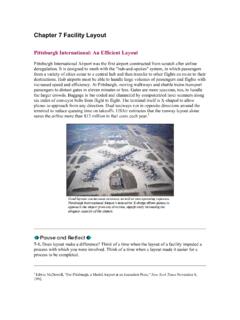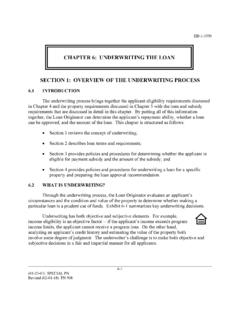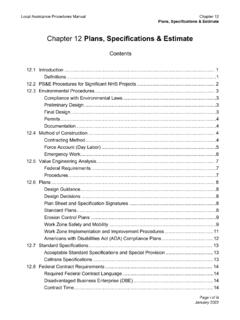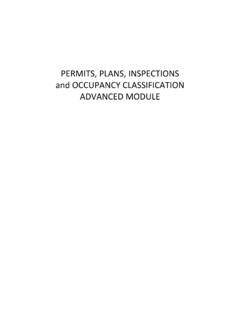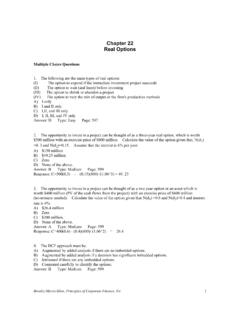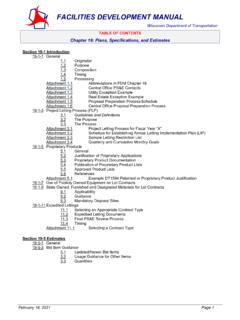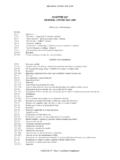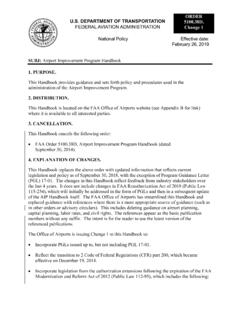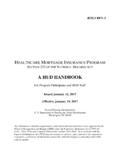Transcription of Data Center Design and Implementation Best Practices
1 ANSI/BICSI 002-2019 data Center Design and Implementation best Practices Committee Approval: January 21, 2019 ANSI Final Action: February 8, 2019 First Published: May 1, 2019 DEMONSTRATION VERSIONNOT FOR RESALEDEMONSTRATION VERSION ONLY NOT FOR RESALE i BICSI International Standards BICSI international standards contain information deemed to be of technical value to the industry and are published at the request of the originating committee. The BICSI International Standards Program subjects all of its draft standards to a rigorous public review and comment resolution process, which is a part of the full development and approval process for any BICSI international standard. The BICSI International Standards Program reviews its standards at regular intervals. By the end of the fifth year after a standard s publication, the standard will be reaffirmed, rescinded, or revised according to the submitted updates and comments from all interested parties.
2 Suggestions for revision should be directed to the BICSI International Standards Program, care of BICSI. Copyright This BICSI document is a standard and is copyright protected. Except as permitted under the applicable laws of the user's country, neither this BICSI standard nor any extract from it may be reproduced, stored in a retrieval system or transmitted in any form or by any means, electronic, photocopying, recording, or otherwise, without prior written permission from BICSI being secured. Requests for permission to reproduce this document should be addressed to BICSI. Reproduction may be subject to royalty payments or a licensing agreement. Violators may be prosecuted. Published by: BICSI 8610 Hidden River Parkway Tampa, FL 33637-1000 USA Copyright 2019 BICSI All rights reserved Printed in DEMONSTRATION VERSION ONLY NOT FOR RESALE ANSI/BICSI 002-2019 ii Notice of Disclaimer and Limitation of Liability BICSI standards and publications are designed to serve the public interest by offering information communication and technology systems Design guidelines and best Practices .
3 Existence of such standards and publications shall not in any respect preclude any member or nonmember of BICSI from manufacturing or selling products not conforming to such standards and publications, nor shall the existence of such standards and publications preclude their voluntary use, whether the standard is to be used either domestically or internationally. By publication of this standard, BICSI takes no position respecting the validity of any patent rights or copyrights asserted in connection with any item mentioned in this standard. Additionally, BICSI does not assume any liability to any patent owner, nor does it assume any obligation whatever to parties adopting the standard or publication. Users of this standard are expressly advised that determination of any such patent rights or copyrights, and the risk of infringement of such rights, are entirely their own responsibility.
4 This standard does not purport to address all safety issues or applicable regulatory requirements associated with its use. It is the responsibility of the user of this standard to review any existing codes and other regulations recognized by the national, regional, local, and other recognized authorities having jurisdiction (AHJ) in conjunction with the use of this standard. Where differences occur, those items listed within the codes or regulations of the AHJ supersede any requirement or recommendation of this standard. All warranties, express or implied, are disclaimed, including without limitation, any and all warranties concerning the accuracy of the contents, its fitness or appropriateness for a particular purpose or use, its merchantability and its non-infringement of any third-party s intellectual property rights.
5 BICSI expressly disclaims any and all responsibilities for the accuracy of the contents and makes no representations or warranties regarding the content s compliance with any applicable statute, rule, or regulation. BICSI shall not be liable for any and all damages, direct or indirect, arising from or relating to any use of the contents contained herein, including without limitation any and all indirect, special, incidental, or consequential damages (including damages for loss of business, loss of profits, litigation, or the like), whether based upon breach of contract, breach of warranty, tort (including negligence), product liability or otherwise, even if advised of the possibility of such damages. The foregoing negation of damages is a fundamental element of the use of the contents hereof, and these contents would not be published by BICSI without such limitations.
6 DEMONSTRATION VERSION ONLY NOT FOR RESALE data Center Design and Implementation best Practices iii TABLE OF CONTENTS PREFACE .. xxvii 1 Introduction .. 1 General .. 1 Purpose .. 1 Users Within IT .. 1 Users Within Facilities Group .. 1 Staff Outside IT and Facilities Groups .. 2 Categories of Criteria .. 2 2 Scope .. 2 3 Required Standards and Documents .. 3 4 Definitions, Acronyms, Abbreviations, and Units of Measurement .. 7 Definitions .. 7 Acronyms and Abbreviations .. 25 Units of Measurement .. 27 5 Site Selection .. 29 Introduction .. 29 Site Evaluation .. 29 General Requirements .. 29 General Recommendations .. 29 Risk Assessment .. 29 Cost Evaluation Recommendations .. 30 Existing Facilities Requirements .. 30 Natural Hazards .. 31 Introduction.
7 31 General Requirements .. 31 Seismic Activity .. 31 Volcanic Activity .. 31 Wildfire .. 33 Flood Plains .. 33 Wind .. 34 Natural Environment .. 34 Introduction .. 34 Ground Stability .. 34 Lightning .. 35 Groundwater .. 36 Air Quality .. 36 Noise .. 37 Other Topography and Natural Environment Recommendations .. 37 Man-Made Hazards .. 37 Introduction .. 37 Recommended Separation Distances .. 37 Other Recommendations .. 37 DEMONSTRATION VERSION ONLY NOT FOR RESALE ANSI/BICSI 002-2019 iv Site Access and Location .. 39 Public Road Access Recommendations .. 39 Adjacent Property .. 40 Proximity to Existing or Redundant data Center .. 40 Security and Emergency Services .. 40 Proximity to Skilled Labor .. 40 Utility Services .. 41 Introduction.
8 41 Power and Electrical Service .. 41 Communications .. 44 Water Service .. 45 Sanitary Sewer .. 47 Natural Gas and Other Fuels .. 47 Regulations (Local, Regional, Country) .. 48 Air Quality Requirements .. 48 Noise Requirements .. 48 Towers and Tall Structures Requirements .. 48 Fuel Tanks Requirements .. 48 Generator Requirements .. 48 Site Access and Required Parking .. 48 Setbacks and Sight Lines .. 48 Environmental Assessment .. 48 6 Space Planning .. 49 Overall Facility Capacity .. 49 General .. 49 Module and Modular Design .. 49 Power Systems .. 50 Introduction .. 50 Electric Utility Service Feeds .. 56 Generator Power .. 56 Cooling 57 Introduction .. 57 Recommendations .. 58 Additional Information .. 59 data Center Supporting Spaces.
9 59 Adjacencies of Functional Spaces .. 59 Security .. 61 Telecommunications Entrance Room .. 62 Command Center .. 63 Helpdesk .. 63 63 Loading Dock .. 63 Storage .. 64 Engineering Offices .. 64 Administrative .. 65 Environmental Design .. 65 Waste/Recycle .. 65 Placement of Equipment When Using Access Floors .. 65 Cooling .. 65 Power Distribution .. 66 Fire Protection Systems .. 67 DEMONSTRATION VERSION ONLY NOT FOR RESALE data Center Design and Implementation best Practices v Computer Room .. 67 Introduction .. 67 Telecommunciations Spaces and Areas .. 68 Equipment Racks and Frames .. 68 Computer Room Layout .. 71 Adjacencies and Other Space Considerations .. 75 Design for Performance .. 77 Introduction .. 77 data Center Metrics.
10 78 Scalability .. 79 Instrumentation and Control .. 79 data Center Energy Saving Design Opportunities .. 80 7 Architectural .. 81 Facilities Planning .. 81 General Overview .. 81 Site Selection .. 81 data Center Location Relative to Ground Level .. 82 General Design Concepts .. 82 Levels of Reliability .. 82 Facility Purpose .. 82 Multiuser Versus Single User Groups .. 83 Equipment Change Cycle .. 83 Occupied Versus Unoccupied data Centers .. 83 data Center Location Within Building .. 83 Type of Building .. 83 Multitenant Buildings .. 84 24/7 Operation of data Center .. 84 Temperature and Humidity Control .. 84 Materials .. 84 General Paths of Access .. 84 General Access .. 84 data Center Access .. 85 Equipment Access .. 85 Telecommunications Access Provider Entry into Computer Rooms.






